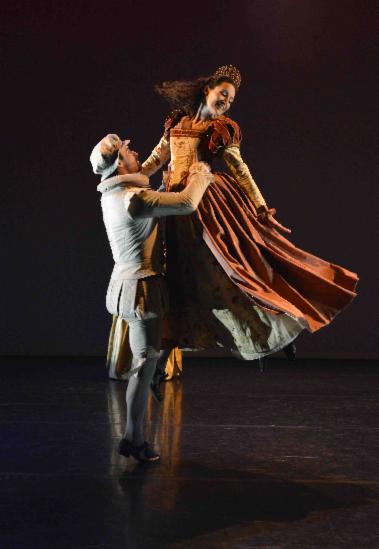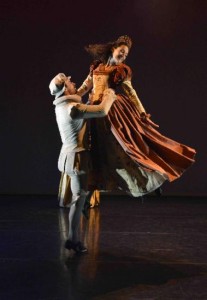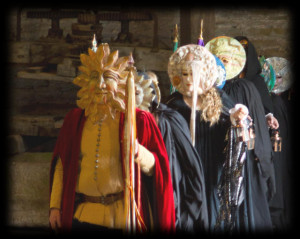The dances popular at the courts of Europe in first quarter of the sixteenth century are largely those described in the Early Renaissance article. Certainly people are still showing interest in them in the 1520s and early 1530s.
Few choreographies survive from the second quarter of the sixteenth century, and most of these are looking back towards the fifteenth century or describing the evolution of the basse dance, but from other evidence we can at least make an informed guess about what was going on. The pavan and its companion dance the galliard were gaining popularity and there are musical arrangements for the closely related passamezzo from 1536. The basse dance was still in use into the 1550s, but it was changing from the triple time dance of the fifteenth century to the duple time dance described by Arbeau in 1589. The first evidence for the almain (music and a mention by Rabelais) is in the mid 1540s. The French bransles described by Arbeau can be dated back to 1530 when the first bransle tunes appear in a collection of dance music and there is music for a coranto in the Phalèse lute book of 1549.
From the 1580s onwards we have a good set of sources that allow us to reconstruct a range of dances with a fair amount of confidence. These dances are considerably different in style to those of the Early Renaissance, their increased formality echoing comparable changes in dress. Men and women still dance much the same steps, allowing for two factors — the heavy skirts being worn by women and the sprezzatura expected of young men, who often interpolated spritely jumps and turns. Steps still start with the left foot, something that feels rather odd to dancers today.
The dancing highlight of the later sixteenth century was the galliard, a lively vigorous dance said to have gained at least one gentleman an important position at court.
Queen Elizabeth herself was an accomplished dancer who is reported to have ‘learnt in the Italian manner to dance high’ and to have been impatient of poor performance among her Maids in Waiting. In the courts of Italy and France, dance also played an important role. It was the formidable Catherine de’ Medici who introduced the works of the Italian dancing masters, Caroso and Negri, to France. Mary, Queen of Scots, with her close links to the French court, also played her part in introducing French, and possibly Italian, dance styles to Scotland.
The Dances
A good deal of our knowledge of popular French dance comes from Thoinot Arbeau, the pen name of French cleric Jehan Tabourot (1519–1595). His Orchesography (1588) describes many dances, including regional varieties of branle, several galliard variations and a gavotte. He also includes the volte (or la volta), delighted in by Queen Elizabeth, the sword dance Buffens and the courante (known in England as coranto). Thanks to Dominique Bourassa of Yale University Library, we know that a copy of Arbeau’s Orchesography was handed on from dancing master to dancing master up until the early 19th century, when it entered the library of the Nederlands Muziek Instituut in the Hague. It seems he was never forgotten.
As in the previous century, however, the really stlylish dancing masters were Italian. Italian dancing masters were attached to courts all across Europe. About 150 of their dances are known to us through the books, most notably, of Fabritio Caroso (1526/1535–1605/1620) and Cesare Negri (c1535–c1605). Copies of their manuals were in the royal libraries of the UK and are now in the British Library. Their books are sophisticated expositions of the etiquette and aesthetics of dance as well as the intricacies of steps and patterns. Each dance has its own music, presented either in notation or in lute tablature.
Most of these dances show a strong emphasis on symmetry. They are extremely varied, including large group dances, circular, longways, trio and couple dances, etc. Some are humorous — flirtatious or miming — some athletic and technically demanding, some are obviously meant to enhance and entertain at some grand occasion. There are several different rhythms within the dances, notably the cascarda (a lively triple rhythm) and the passamezzo (akin to the pavan). The common use of two or three of these varying rhythms in a single dance produces the effect of a short suite. Livio da Lupi da Caravaggio (1607)wrote Il Libro di Gagliarda, Tordiglione, Passa mezzo, Canari e Passggi (Palermo, 1607) offering numerous variations on the galliard, tordiglione, passamezzo and canaries, showing that there was a demand for professionally designed routines to be used in personal improvisation.
The step vocabulary used in the dances of late sixteenth-century Italy became well- codified and very elaborate. For example, Caroso’s Nobilità di Dame (1600) provides a list of steps containing descriptions for 3 differnet riverenze, 4 continenzi, 3 passi puntati, 5 types of passi, 12 seguiti, 4 doppi or doubles, 2 trabucchetti, 4 fioretti, 3 salti, 6 caprioli plus 25 other steps, such as balzetti, corinti, groppi, trangi etc. Understandably, modern interpretations of Caroso’s descriptions remain controversial. And of course there remain Negri’s steps to consider as well. At this period, interest focused on complex and vigorous footwork, as the upright torso – for ladies and many men – was firmly encased in a corset or ‘stays’. The music is more accessible to modern ears than that of earlier periods and presents fewer problems of interpretation. There is nevertheless considerable variation in the tempi adopted by dancers and teachers today.
Dancing in England
Some English dances are recorded for us in the Inns of Court manuscripts of approximately 1570-1650. Named for the various precincts where lawyers traditionally lodged, trained and worked, these manuscript records of dances display the fact that knowledge of dancing was considered an important skill, and was pursued by young men along with education in law. The Inns of Court held dances twice a year, on Hallowmas (31 October) and Candlemas (February 2). These events became increasingly rowdy and the last one recorded was in 1774. The various MSS contain no step descriptions and, up to 1600, no music. The dances include a number of measures and almaines, the Quadran Pavan, several perfunctorily described galliards and a miscellany of other dances. It seems that all participants were expected to know the dances. The galliard commonly followed the solemn pavan, which, although apparently simple, exemplifies the stateliness and elegance of the period. This pavan–galliard combination had a far-reaching effect on contemporary musical development.
Sir John Davies long poem Orchestra (1594) is a vivid source for ideas about the importance of dance to society, though it is susceptible to rather varying interpretations. Shakespeare’s plays too contain many references to dance and occasionally give some idea of how dances were done and their social context. For example, he specifically mentions the galliard, the cinquepace, the coranto, the Measures, La Volta, Canaries and the branle. Famously, a ball provides the occasion for Romeo to meet Juliet and many of the comedies end with dancing as a celebration of reconciliation and harmony.
We only know country dancing, so popular with Elizabeth in the later years of her reign, through John Playford’s 1651 publication of The English Dancing Master, explored separately in another section of this guide. See English Country Dance. However, several of the dances in the first edition were known around 1600, for example Sellengers Round, and several more use tunes popular considerably earlier.
The court of James I saw a brief flowering of the tradition of the masque, a courtly entertainment incorporating poetry, rhetoric, music and dance. These highly codified entertainments carried dynastic and political meaning together with some philosophical and some lighthearted content. Courtiers, including Queen Anne herself, took part in the dignified elements, while professional dancers and younger courtiers capered in the anti-masques. These masques followed in a Renaissance tradition that stemmed from Italy and gained ground in the court of Louis XIV. Unfortunately, rather little dance information survives.
Some Resources on the Net
- Fabritio Caroso, Il Ballarino, a facsimile and much other material
http://www.pbm.com/~lindahl/caroso/
- Cesare Negri, Le Gratie d’Amore (1602/4), a facsimile and much other material http://www.pbm.com/~lindahl/negri/
- Renaissance Dance
http://www.rendance.org/
Home of the Rendance mailing list. Also includes background information about Renaissance dance. - SCA Renaissance Dance Homepage
http://www.pbm.com/~lindahl/dance.html
Extensive pages of the Society for Creative Anachronism (SCA). Includes background information, primary sources, analysis and links. - Orchesographie
http://www.graner.net/nicolas/arbeau/
An HTML transcription of Arbeau’s Orchesographie (1589).
Primary Sources
Anon., Instruction pour dancer (before 1612) (facsimile and transcription, A. Feves et al., Freiburg, 2000).
Th. Arbeau, Orchésographie (Langres, 1588; facsimiles, Genève, 1972, & Langres, 1988; translation by M. S. Evans, 1948, reprinted, New York, 1967).
F. Caroso, Il Ballarino (Venezia, 1588; facsimile, New York, 1967).
F. Caroso, Nobiltà di Dame (Milano, 1600; facsimile, Bologna, 1980).
Lutio Compasso, Ballo della Gagliarda (Firenze, 1560; facsimile, Freiburg, 1995).
C. Negri, Le Gratie d’Amore (Milano, 1602; facsimiles, New York, 1969, & Bologna, 1969).
Ercole Santucci, Mastro da Ballo (1614; facsimile with introduction by B. Sparti, Hildersheim, 2004).
The ‘Inns of Court MSS’ are transcribed by I. Payne in The Almain in Britain c.1549–c.1675 (Aldershot, 2003).
Secondary Sources
D. Bevington & P. Holbrook eds., The Politics of the Stuart Court Masque (Cambridge, 1998).
M. Collins, The Art That All Other Arts Do Approve: Teaching Aspects of Tudor and Stuart History Through Early Dance and Its Music (London 1993)
J. Caldwell, ed. The Mulliner Book, Musica Britannica 1. (Stainer & Bell, 2011).
J. Dillon, The Language of Space in Court Performance, 1400-1625 (Cambridge, 2010).
S. Howard The Politics of Courtly Dancing in Early Modern England (Amhurst, 1998).
J. P. Cunningham, Dancing in the Inns of Court (London, 1965).
M. Lehner, A Manual of Sixteenth-Century Italian Dance Steps (Freiburg, 1997).
B. Ravelhofer, The Early Stuart Masque, Dance, Costume, and Music (Oxford.2006).
J. Sutton, Nobiltà di Dame / Fabritio Caroso (translation and introduction, Oxford, 1986); 2nd ed., Courtly Dance of the Renaissance (New York & London, 1995).
E. Tribble, “Dancing, Music and Song” in Early Modern Actors & Shakespeare’s Theatre (London, 2017).
J. Ward. “Apropos The olde Measures” in Records of Early English Drama (University of Toronto Press, 1993). 2-21.
D. R. Wilson, “Dancing in the Inns of Court” in Historical Dance II, v, (DHDS 1986-7), 3-16.
See Learning the Dances for details of instruction-books and recorded music produced by the Dolmetsch Historical Dance Society (now HDS Historical Dance Society), Gaita and by Nonsuch Productions and others. These give interpretations of how to dance many of these dances, along with their music and some background information.
General Books on Historical or Early Dance
M. Dolmetsch, Dances of England and France from 1450 to 1600 (London, 1949; reprinted, New York, 1976)
M. Dolmetsch, Dances of Spain and Italy from 1400 to 1600 (London, 1954; reprinted, New York, 1975) A. H. Franks, Social Dance, A Short History (London, 1963) I. Guest, The Dancer’s Heritage, a Short History of Ballet (London, 1960). Unlike many historians of dance, Ivor Guest uses his first 3 chapters to survey developments in dance from the 15th century to Romantic ballet.
B. Quirey, May I have the Pleasure? The story of popular dancing (London, 1976; reprinted, 1987)
B. Quirey & M. Holmes, Apology for History (London, 1993)
C. Sachs, World History of the Dance (English version, New York, 1937; reprinted, 1963)
J. Wildeblood, The Polite World (London, 1965; revised ed., 1973)
M. Wood, Historical Dances (Twelfth to Nineteenth Century) (London, 1952; reprinted, 1982)
M. Wood, More Historical Dances (London, 1956)
M. Wood, Advanced Historical Dances (London, 1960)




